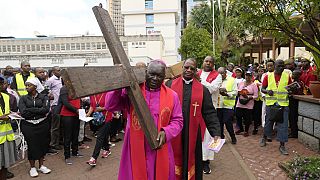Easter
In Western Serbia, coronavirus hasn't stopped tradition as villagers are making huge beeswax candles for the local monastery for Orthodox Easter.
Residents of two clusters of villages in the Jadar region of Western Serbia busy themselves during the Holy Week, leading up to Orthodox Easter.
They collect donations of bees wax from local households to create two special "farmers' candles" for the local monastery.
This centuries-old local ritual is a chance for farmers to ask for God's blessing on their crops and overall well-being.
They collect donations of beeswax from local households to create two special "farmers' candles" for the local monastery.
The ritual lasts several days.
The collected bee wax and is used it to cast two massive candles - each up to 1.5 meters tall and weighing around 50 kilograms -
They then present them to the Tronosa monastery-
The process takes several days and includes the work of two villages but they are not just candles for the monastery.
"They are called farmers' candles because they are offered for the protection of our crops and our fruit groves from bad weather and hail," said Zajaca villager Ranko Nikolic.
The tradition is on Maundy Thursday - which commemorates the Last Supper and Jesus washing the feet of his disciples - two processions take place.
**The strongest men **
The strongest men in the villages carry their community's candle through fields and forests to the Tronosa monastery.
The processions meet and the candles are carried to the monastery where are blessed by priests.
The massive candles are positioned near the altar to be used in all liturgical prayers there until the next Easter.
The remaining way is used for the next farmers' candle.
This year and the last, for protection against the uncontrolled spread of the coronavirus in the village communities, the church authorities recommended that the candles be walked to the monastery only by small groups of villagers.
Still, some 200 people took part in the processions and converged in the courtyard of the monastery church to witness the candles being blessed and carried to the altar.
While there are no proper historical records to confirm the origin of the monastery itself, it is widely believed to have been built in 1317 by a medieval Serbian King.
During the nearly 500 years of Ottoman rule over present-day Serbia, which commenced in 1459, the original structure was repeatedly raided, destroyed and rebuilt on old foundations before assuming its present form in 1834.











01:00
Honoring Srebrenica, a call for remembrance and solidarity
02:00
Orthodox Christians in Ethiopia celebrated Easter [No Comment]
01:21
Ethiopian Orthodox Christians around the world celebrate Easter
01:30
Ethiopian Orthodox Christians celebrate Palm Sunday
00:40
Easter sunday: pope calls for the end of conflicts
01:03
Ivorian Catholics observe Good Friday in Abidjan